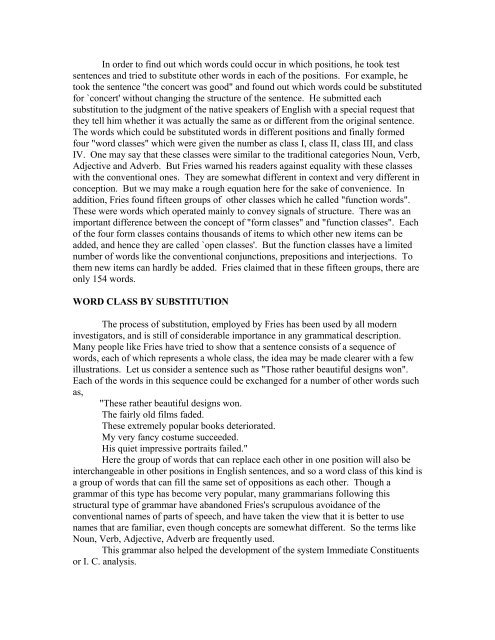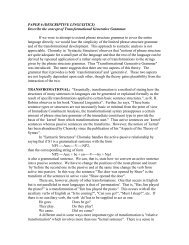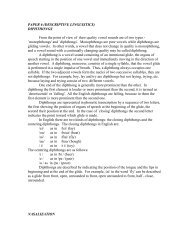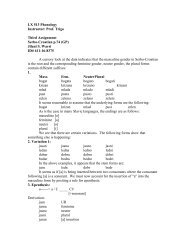Structural Grammar - Jilani S. Warsi
Structural Grammar - Jilani S. Warsi
Structural Grammar - Jilani S. Warsi
Create successful ePaper yourself
Turn your PDF publications into a flip-book with our unique Google optimized e-Paper software.
In order to find out which words could occur in which positions, he took test<br />
sentences and tried to substitute other words in each of the positions. For example, he<br />
took the sentence "the concert was good" and found out which words could be substituted<br />
for `concert' without changing the structure of the sentence. He submitted each<br />
substitution to the judgment of the native speakers of English with a special request that<br />
they tell him whether it was actually the same as or different from the original sentence.<br />
The words which could be substituted words in different positions and finally formed<br />
four "word classes" which were given the number as class I, class II, class III, and class<br />
IV. One may say that these classes were similar to the traditional categories Noun, Verb,<br />
Adjective and Adverb. But Fries warned his readers against equality with these classes<br />
with the conventional ones. They are somewhat different in context and very different in<br />
conception. But we may make a rough equation here for the sake of convenience. In<br />
addition, Fries found fifteen groups of other classes which he called "function words".<br />
These were words which operated mainly to convey signals of structure. There was an<br />
important difference between the concept of "form classes" and "function classes". Each<br />
of the four form classes contains thousands of items to which other new items can be<br />
added, and hence they are called `open classes'. But the function classes have a limited<br />
number of words like the conventional conjunctions, prepositions and interjections. To<br />
them new items can hardly be added. Fries claimed that in these fifteen groups, there are<br />
only 154 words.<br />
WORD CLASS BY SUBSTITUTION<br />
The process of substitution, employed by Fries has been used by all modern<br />
investigators, and is still of considerable importance in any grammatical description.<br />
Many people like Fries have tried to show that a sentence consists of a sequence of<br />
words, each of which represents a whole class, the idea may be made clearer with a few<br />
illustrations. Let us consider a sentence such as "Those rather beautiful designs won".<br />
Each of the words in this sequence could be exchanged for a number of other words such<br />
as,<br />
"These rather beautiful designs won.<br />
The fairly old films faded.<br />
These extremely popular books deteriorated.<br />
My very fancy costume succeeded.<br />
His quiet impressive portraits failed."<br />
Here the group of words that can replace each other in one position will also be<br />
interchangeable in other positions in English sentences, and so a word class of this kind is<br />
a group of words that can fill the same set of oppositions as each other. Though a<br />
grammar of this type has become very popular, many grammarians following this<br />
structural type of grammar have abandoned Fries's scrupulous avoidance of the<br />
conventional names of parts of speech, and have taken the view that it is better to use<br />
names that are familiar, even though concepts are somewhat different. So the terms like<br />
Noun, Verb, Adjective, Adverb are frequently used.<br />
This grammar also helped the development of the system Immediate Constituents<br />
or I. C. analysis.





